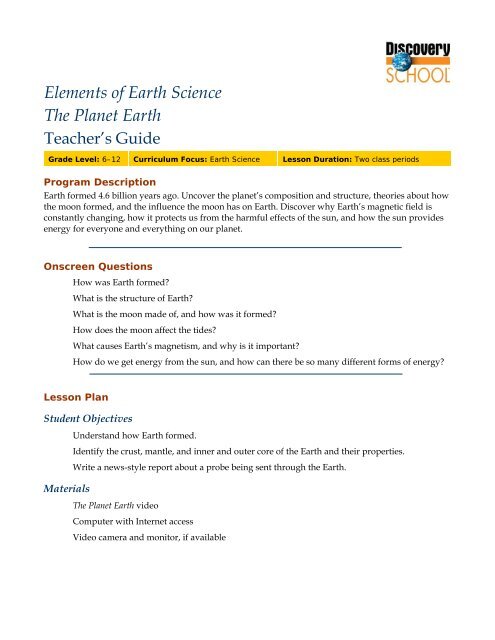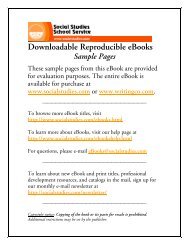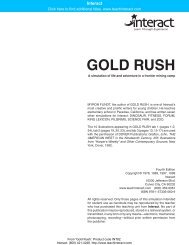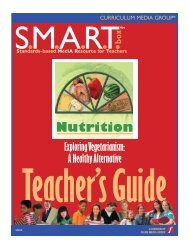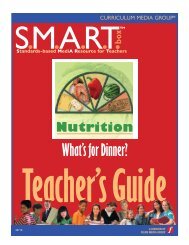Elements of Earth Science The Planet Earth - Free Teacher Resources
Elements of Earth Science The Planet Earth - Free Teacher Resources
Elements of Earth Science The Planet Earth - Free Teacher Resources
You also want an ePaper? Increase the reach of your titles
YUMPU automatically turns print PDFs into web optimized ePapers that Google loves.
<strong>Elements</strong> <strong>of</strong> <strong>Earth</strong> <strong>Science</strong><br />
<strong>The</strong> <strong>Planet</strong> <strong>Earth</strong><br />
<strong>Teacher</strong>’s Guide<br />
Grade Level: 6–12 Curriculum Focus: <strong>Earth</strong> <strong>Science</strong> Lesson Duration: Two class periods<br />
Program Description<br />
<strong>Earth</strong> formed 4.6 billion years ago. Uncover the planet’s composition and structure, theories about how<br />
the moon formed, and the influence the moon has on <strong>Earth</strong>. Discover why <strong>Earth</strong>’s magnetic field is<br />
constantly changing, how it protects us from the harmful effects <strong>of</strong> the sun, and how the sun provides<br />
energy for everyone and everything on our planet.<br />
Onscreen Questions<br />
How was <strong>Earth</strong> formed?<br />
What is the structure <strong>of</strong> <strong>Earth</strong>?<br />
What is the moon made <strong>of</strong>, and how was it formed?<br />
How does the moon affect the tides?<br />
What causes <strong>Earth</strong>’s magnetism, and why is it important?<br />
How do we get energy from the sun, and how can there be so many different forms <strong>of</strong> energy?<br />
Lesson Plan<br />
Student Objectives<br />
Understand how <strong>Earth</strong> formed.<br />
Identify the crust, mantle, and inner and outer core <strong>of</strong> the <strong>Earth</strong> and their properties.<br />
Write a news-style report about a probe being sent through the <strong>Earth</strong>.<br />
Materials<br />
<strong>The</strong> <strong>Planet</strong> <strong>Earth</strong> video<br />
Computer with Internet access<br />
Video camera and monitor, if available
<strong>Elements</strong> <strong>of</strong> <strong>Earth</strong> <strong>Science</strong>: <strong>The</strong> <strong>Planet</strong> <strong>Earth</strong><br />
<strong>Teacher</strong>’s Guide 2<br />
Procedures<br />
1. Explain to students that they will be creating 3-4 minute news segments about an imaginary<br />
probe traveling through <strong>Earth</strong>. <strong>The</strong> segments should be similar to how a TV science reporter<br />
might cover the launch <strong>of</strong> a space probe.<br />
2. Divide the class into groups and assign each group a layer <strong>of</strong> the <strong>Earth</strong>. (You may want to<br />
divide the mantle into upper and lower sections, or assign a group to give a brief overview <strong>of</strong><br />
all the layers and how they were formed.) Using a globe, select an entrance point for the probe<br />
and determine where it would exit <strong>Earth</strong>. If the probe is launched from a continent but exits in<br />
an ocean what differences might it encounter in breaking through the crust?<br />
3. Have students research their assigned layer. <strong>The</strong> following sites are good starting points for<br />
exploring <strong>Earth</strong>’s layers online:<br />
http://www.usgs.gov/science/science.php?term=292<br />
http://mediatheek.thinkquest.nl/~ll125/en/struct.htm<br />
http://scign.jpl.nasa.gov/learn/plate1.htm<br />
http://pubs.usgs.gov/publications/text/inside.html<br />
http://www.solarviews.com/eng/earthint.htm<br />
http://www.palaeos.com/<strong>Earth</strong>/Geosphere/structure.htm<br />
4. Students should look for answers to the following questions:<br />
• How thick is the layer?<br />
• What is its composition?<br />
• Is the layer liquid, solid, or semi-liquid? If the material is liquid or semi-liquid, what<br />
affect does its movement have on the planet?<br />
• What is the temperature?<br />
• What is the significance <strong>of</strong> this layer?<br />
5. After students have completed their research have each group compile their results into a report<br />
that describes what the probe will encounter as it makes its way through a particular layer.<br />
Here the students can get creative, giving the probe special features to force its way through<br />
solid material and withstand extremely high temperatures.<br />
6. Set up the video camera and have a representative <strong>of</strong> each group act as the on-camera reporter<br />
to deliver the group’s findings to the class.<br />
Published by Discovery Education. © 2005. All rights reserved.
<strong>Elements</strong> <strong>of</strong> <strong>Earth</strong> <strong>Science</strong>: <strong>The</strong> <strong>Planet</strong> <strong>Earth</strong><br />
<strong>Teacher</strong>’s Guide 3<br />
Assessment<br />
Use the following three-point rubric to evaluate students' work during this lesson.<br />
Vocabulary<br />
3 points: Students were highly engaged in class discussions; conducted thorough research;<br />
presented a creative and accurate report.<br />
2 points: Students were somewhat engaged in class discussions; conducted adequate research;<br />
presented an acceptable report.<br />
1 point: Students were not engaged in class discussions; did not conduct adequate<br />
research; did not present an acceptable report.<br />
crust<br />
Definition: <strong>The</strong> topmost layer <strong>of</strong> <strong>Earth</strong>, composed essentially <strong>of</strong> crystalline rock<br />
Context: Oceanic crust is much thinner than continental crust.<br />
electromagnetic<br />
Definition: Magnetism developed by a current <strong>of</strong> electricity<br />
Context: <strong>The</strong> sun’s energy travels to <strong>Earth</strong> as electromagnetic waves that provide us with both<br />
heat and light.<br />
inner core<br />
Definition: <strong>The</strong> solid, extremely dense innermost region <strong>of</strong> <strong>Earth</strong><br />
Context: Although the temperature <strong>of</strong> <strong>Earth</strong>’s inner core is about 7,000 degrees Celcius, it’s<br />
under such tremendous pressure that it remains solid.<br />
magnetosphere<br />
Definition: <strong>The</strong> region <strong>of</strong> space surrounding <strong>Earth</strong> that is dominated by a magnetic field<br />
Context: <strong>The</strong> magnetosphere deflects much <strong>of</strong> the solar wind, preventing particles from the sun<br />
from hitting <strong>Earth</strong>.<br />
mantle<br />
Definition: <strong>The</strong> layer <strong>of</strong> <strong>Earth</strong> that lies beneath the crust and above the central core<br />
Context: <strong>The</strong> mantle contains about 83 percent <strong>of</strong> <strong>Earth</strong>’s volume.<br />
outer core<br />
Definition: <strong>The</strong> layer <strong>of</strong> <strong>Earth</strong> located below the mantle<br />
Context: <strong>The</strong> outer core is about the same temperature as the inner core, but because it is under<br />
less pressure, it is molten.<br />
Published by Discovery Education. © 2005. All rights reserved.
<strong>Elements</strong> <strong>of</strong> <strong>Earth</strong> <strong>Science</strong>: <strong>The</strong> <strong>Planet</strong> <strong>Earth</strong><br />
<strong>Teacher</strong>’s Guide 4<br />
photosynthesis<br />
Definition: <strong>The</strong> process by which green plants and certain other organisms transform light into<br />
chemical energy<br />
Context: Life began on <strong>Earth</strong> about 3.8 billion years ago, when tiny a bacterium first used<br />
photosynthesis to make its own food.<br />
Standards<br />
National Academy <strong>of</strong> <strong>Science</strong>s<br />
<strong>The</strong> National Academy <strong>of</strong> <strong>Science</strong>s provides guidelines for teaching science in grades K–12 to<br />
promote scientific literacy. To view the standards, visit this Web site:<br />
http://books.nap.edu/html/nses/html/overview.html#content.<br />
This lesson plan addresses the following national standards:<br />
• <strong>Earth</strong> and Space <strong>Science</strong>: Structure <strong>of</strong> the <strong>Earth</strong> system; <strong>Earth</strong>’s history<br />
Mid-continent Research for Education and Learning (McREL)<br />
McREL's Content Knowledge: A Compendium <strong>of</strong> Standards and Benchmarks for K-12 Education<br />
addresses 14 content areas. To view the standards and benchmarks, visit<br />
http://www.mcrel.org/compendium/browse.asp<br />
This lesson plan addresses the following national standards:<br />
• <strong>Science</strong>: <strong>Earth</strong> and Space <strong>Science</strong>s—Understands <strong>Earth</strong>'s composition and structure<br />
Support Materials<br />
Develop custom worksheets, educational puzzles, online quizzes, and more with the free teaching tools<br />
<strong>of</strong>fered on the Discoveryschool.com Web site. Create and print support materials, or save them to a<br />
Custom Classroom account for future use. To learn more, visit<br />
• http://school.discovery.com/teachingtools/teachingtools.html<br />
Published by Discovery Education. © 2005. All rights reserved.
<strong>Elements</strong> <strong>of</strong> <strong>Earth</strong> <strong>Science</strong>: <strong>The</strong> <strong>Planet</strong> <strong>Earth</strong><br />
<strong>Teacher</strong>’s Guide 5<br />
DVD Content<br />
This program is available in an interactive DVD format. <strong>The</strong> following information and activities are<br />
specific to the DVD version.<br />
How To Use the DVD<br />
<strong>The</strong> DVD starting screen has the following options:<br />
Play Video—This plays the video from start to finish. <strong>The</strong>re are no programmed stops, except by<br />
using a remote control. With a computer, depending on the particular s<strong>of</strong>tware player, a pause<br />
button is included with the other video controls.<br />
Video Index—Here the video is divided into sections indicated by video thumbnail icons. Watching<br />
all parts in sequence is similar to watching the video from start to finish. Brief descriptions and total<br />
running times are noted for each part. To play a particular segment, press Enter on the remote for<br />
TV playback; on a computer, click once to highlight a thumbnail and read the accompanying text<br />
description and click again to start the video.<br />
Curriculum Units—<strong>The</strong>se are specially edited video segments pulled from different sections <strong>of</strong> the<br />
video (see below). <strong>The</strong>se nonlinear segments align with key ideas in the unit <strong>of</strong> instruction. <strong>The</strong>y<br />
include onscreen pre- and post-viewing questions, reproduced below in this <strong>Teacher</strong>’s Guide. To<br />
play a particular segment, press Enter on the TV remote or click once on the Curriculum Unit title<br />
on a computer.<br />
Standards Link—Selecting this option displays a single screen that lists the national academic<br />
standards the video addresses.<br />
<strong>Teacher</strong> <strong>Resources</strong>—This screen gives the technical support number and Web site address.<br />
Video Index<br />
I. <strong>The</strong> History <strong>of</strong> the <strong>Earth</strong> (5 min.)<br />
<strong>The</strong> <strong>Earth</strong> formed when gravity pulled galactic dust and gas into a core about 4.6 billion years ago.<br />
Discover how different elements came together to form the planet.<br />
Pre-viewing question<br />
Q: How did the planets form?<br />
A: Dust and gas left over from the sun’s formation began to come together. As an object got bigger,<br />
its gravity increased and it drew in more material. <strong>The</strong> largest <strong>of</strong> these objects grew to be planets.<br />
Post-viewing question<br />
Q: What are some <strong>of</strong> the features that make <strong>Earth</strong> capable <strong>of</strong> supporting life?<br />
A: Answers will vary, but the main two are the atmosphere <strong>of</strong> oxygen and nitrogen and the<br />
abundance <strong>of</strong> water.<br />
Published by Discovery Education. © 2005. All rights reserved.
<strong>Elements</strong> <strong>of</strong> <strong>Earth</strong> <strong>Science</strong>: <strong>The</strong> <strong>Planet</strong> <strong>Earth</strong><br />
<strong>Teacher</strong>’s Guide 6<br />
II. <strong>The</strong> <strong>Earth</strong>’s Structure (3 min.)<br />
<strong>Earth</strong> is made up <strong>of</strong> several layers surrounding the solid inner core. Explore what’s happening right<br />
under our feet.<br />
Pre-viewing question<br />
Q: What’s happening under <strong>Earth</strong>’s crust?<br />
A: <strong>The</strong> <strong>Earth</strong>’s interior consists <strong>of</strong> several layers, each <strong>of</strong> varying temperatures and densities.<br />
Post-viewing question<br />
Q: What are the main layers <strong>of</strong> <strong>Earth</strong>?<br />
A: <strong>The</strong> solid inner core, liquid outer core, mantle and crust. <strong>The</strong> crust and top part <strong>of</strong> the mantle are<br />
called the lithosphere.<br />
III. <strong>The</strong> Moon: Its Composition and Origins (5 min.)<br />
<strong>The</strong> moon probably formed about the same time as <strong>Earth</strong>, but it is very different in composition and<br />
structure. Learn more about <strong>Earth</strong>’s only natural satellite.<br />
Pre-viewing question<br />
Q: What is the moon made <strong>of</strong> and how was it formed?<br />
A: Answers will vary.<br />
Post-viewing question<br />
Q: What is the impact theory?<br />
A: It’s a theory on the origin <strong>of</strong> the moon. Scientists believe that not long after <strong>Earth</strong> formed, an<br />
object about the size <strong>of</strong> Mars collided with it, throwing out rocky debris that went into orbit above<br />
<strong>Earth</strong>. Gradually this debris gathered and became the moon.<br />
IV. <strong>The</strong> Moon’s Influence on the <strong>Earth</strong> (4 min.)<br />
<strong>Earth</strong>’s gravity holds the moon in orbit, but the moon’s gravity also affects <strong>Earth</strong>. Discover how the<br />
moon causes the rise and fall <strong>of</strong> tides.<br />
Pre-viewing question<br />
Q: How does the moon affect <strong>Earth</strong>?<br />
A: Answers will vary, but the most well known affect is the rise and fall <strong>of</strong> ocean tides.<br />
Post-viewing question<br />
Q: Why are tidal cycles not the same everywhere on <strong>Earth</strong>?<br />
A: <strong>Earth</strong> is not evenly covered with water, and the coastlines and local conditions make tidal<br />
patterns complicated. Winds and the sun also affect tides.<br />
V. <strong>Earth</strong>’s Magnetic Field (5 min.)<br />
<strong>Earth</strong> is similar to a magnet sending out lines <strong>of</strong> force that create a giant magnetic field around the<br />
planet. Find out what this field tells us about <strong>Earth</strong>’s structure.<br />
Published by Discovery Education. © 2005. All rights reserved.
<strong>Elements</strong> <strong>of</strong> <strong>Earth</strong> <strong>Science</strong>: <strong>The</strong> <strong>Planet</strong> <strong>Earth</strong><br />
<strong>Teacher</strong>’s Guide 7<br />
Pre-viewing question<br />
Q: Why does a compass always point north?<br />
A: A compass is a small magnet, while the <strong>Earth</strong> is a giant magnet. All magnets have two poles,<br />
north and south. <strong>The</strong> magnet on the compass aligns with the north-south direction <strong>of</strong> <strong>Earth</strong>’s<br />
magnetic field.<br />
Post-viewing question<br />
Q: How does the magnetosphere protect <strong>Earth</strong>?<br />
A: It shields the planet from destructive solar winds, streams <strong>of</strong> gases, and particles that blow<br />
outward from the sun.<br />
VI. Energy From the Sun (6 min.)<br />
<strong>The</strong> sun makes life on <strong>Earth</strong> possible. Explore how the sun's energy influences the climate and helps<br />
plants create chemical energy that sustains the life <strong>of</strong> all plants and animals.<br />
Pre-viewing question<br />
Q: How do we get energy from the sun?<br />
A: Answers will vary.<br />
Post-viewing question<br />
Q: What are some <strong>of</strong> the various forms <strong>of</strong> energy that ultimately come from the sun?<br />
A: Chemical energy is created during photosynthesis, when plants convert electromagnetic energy<br />
and store it in their tissues. Fossil fuel, such as gasoline, was formed from the remains <strong>of</strong><br />
microscopic marine animals that lived millions <strong>of</strong> years ago that originally got their energy from<br />
the sun. Wind energy also comes from the sun, through atmospheric heating and cooling. Water<br />
energy can be caused by waves, the friction between wind and water, or by evaporating moisture<br />
created by the sun’s heat, that eventually falls as rain, creating rapids and waterfalls.<br />
Published by Discovery Education. © 2005. All rights reserved.


